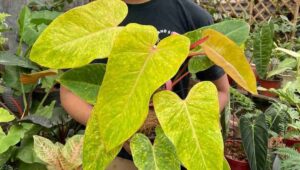Philodendron Painted Lady
All plant lovers and gardeners agree that Philodendrons are the most loved indoor plants. However, did you know? There are 500 species of Philodendrons. Most popular Philodendron varieties include Philodendron Painted Lady and Philodendron Deja Vu, which are ideal for both indoor and outdoor decor. Today, we will explore the Philodendron Painted Lady. This plant earned its name because its yellowish variegation looks like a splash of paint on dark green leaves.

This plant is grown for its beautiful foliage. Although it lacks distinct flowers, the variegated leaf pattern of Painted Lady never ceases to amaze us. The plant grows as an evergreen perennial. Once planted, this plant continues to spread its beauty for more than 7 years or even decades. As a result, you do not need to worry about it regrowing. Moreover, being evergreen means your plant will always have lush green leaves, even in the fall.
Let’s start with Leaves. It has heart-shaped dark green, glossy leaves that are variegated with yellow spots giving it a beautiful appearance. As plants mature, the leaves turn from light green to dark green.
The pink stems and petioles of this plant are another peculiar characteristic. This plant has multiple stems that climb upward from the base. A supportive structure will allow it to produce more leaves, making it even more beautiful.
For those who love floral parts, you may be a little disappointed. Summer/Spring produce small white flowers that are not very attractive. Furthermore, their aroma is bad. This is why many plant experts remove them during the bud stage. Additionally, it allows plants to divert energy from flowering to leaf growth.
If you’re worried about choosing the right plant due to limited space, don’t worry. The plant grows to a maximum height of 2 to 5 feet and spreads to a maximum of 10 to 30 inches. You can also prune it to make it more leafy and compact. Pruning is the process of cutting/trimming of the growing tip, which reduces the dominance of apical branches and promotes the growth of lateral branches. You can grow this beauty in your patio, hanging baskets, terrace, bedroom, bathroom, kitchen, windows, and ladder steps. Do not place it in a corner as it will suffer from light deficiency.
Although it has several good points, it does have a drawback. Consuming this Phil can cause allergies and mouth ulcers. Therefore, keep your pets and children away from it. In addition to Meconostigma and Calostigma, this plant is also known as Baursea, Thaumatophyllum, Telipodus Raf and Arosma Raf. The general information about Painted Lady Philodendron is presented in the table below:-
| Name | Philodendron Painted Lady |
|---|---|
| Scientific Name | |
| Plant Type | Shrub |
| Life Cycle | Perennial |
| Native Climate | Tropical |
| Hardiness Zone | 9-11 |
| Height | 2-5 Feet |
| Width | 10-30 Inches |
| Leaves | Evergreen, Variegated |
| Stem | Multiple, Pink |
| Flower | Small White Flowers |
| Growing Habit | Climber |
| Sunlight | Partial Sun |
| Temperature | Warm (12-16)°C |
| Soil | Sandy Loam |
| Water | Less |
| Toxicity | Yes (Calcium Oxalate In Leaf) |
| Uses | Indoor Decor Plant |
Origin
Philodendron Painted Lady is a cultivar meaning it has been produced by the cross of two different Philodendrons:-
1. P. Erubescens Emerald Queen plant.
2. P. Erubescens Burgundy plant.
The scientific name of this plant is and it is an Aroid (Belonging To Aeraceae Family).
Related Posts:-
Chicken Gizzard Plant: Care And Propagation
Agave Geminiflora: Plant Care, Propagation And Flowering
14 Basement Plants Requiring Low Sunlight
Philodendron Painted Lady Care

Light
Philodendrons, including painted lady, prefer diffused sunlight. They do not like direct sunlight. Therefore, if you want to grow them outdoors, try to keep them in shade. However, avoid complete shade as it may cause dormancy and the plant will become leggy (Etiolation). Alternatively, too much direct sunlight can cause leaves to brown. If you want to keep it indoors, you don’t have to worry; it performs perfectly under fluorescent lights. It can also be placed on the south facing window, slightly pulled back to avoid direct sunlight. In brighter light, however, the variegation is more apparent. If the leaves are completely shaded, the variegation will not appear, and they will be dark green only.
Temperature
Phils like warm climates and aren’t hardy to the cold. The ideal temperature for this plant is 16-24°C. You should bring it indoors if you live in a zone with cold winters, otherwise it may die from cold injury.
Soil
The ideal soil for this plant is light, loose and rich in organic matter. Make sure there is a drainage hole if you are growing it in a pot. To make the soil mixture, combine 50 percent soil, 20 percent sand, 10 percent compost, 10 percent cocopeat, and 10 percent moss/gravel. There shouldn’t be any water stagnation in the soil and the soil should drain well. The pH should be slightly acidic.
Water
The plant doesn’t need to be watered frequently. It can even survive with less water for weeks. It is recommended to irrigate them every 10 days during the summer and every 15 days during the winter. Overwatering will cause the roots to rot and the leaves to yellow. Underwatering causes the leaves to droop and roll. If you are growing it in a pot, make sure the drainage is adequate. Be sure the soil is moist as well as not soggy.
This Philodendron should be watered using the Soak and Dry method. It means that you water thoroughly and allow it to dry completely before watering again. You should water when the top 3 inches of soil are completely dry.
Fertiliser
Fertiliser is necessary for optimal plant growth. You can use slow release fertilizers like Osmocote triannually or water soluble fertilizers (Quick Releasing) monthly. Fertilizer is not needed during the winter because the plants go dormant and stop growing. Once spring arrives, the plant begins to grow again.
Humidity
The Painted Lady Philodendron is a tropical plant that loves humidity. Furthermore, variegated plants require more humidity than non-variegated plants. It is therefore important to maintain humidity during dry weather by misting or using a humidifier. Don’t over mist them since it may increase the chance of fungal infection. Less humidity may cause leaves to brown.
Repotting
Philodendron Painted Lady grows slowly. It doesn’t need to be reported for two years after planting. Repotting is necessary when the plant is root bound and roots are emerging from the draining hole. The new pot should be slightly larger than the old one. Spring is the best time for repotting.
Pot/Container Size
This Phil can be grown in pots, containers or hanging baskets of 4, 6 or 8 inches in diameter. For the plant to grow upright, a support should be provided.
Philodendron Painted Lady Propagation
Propagation of the Painted Lady Philodendron isn’t difficult. It should be propagated during the Spring season. We can propagate by two methods:-
Cuttings
•First select a healthy growing stem.
•Cut the stem at one point just above a node. The length of cutting should be (6-8) inches. The cutting should be slanting (For Maximum Surface Area).
•Remove the lower leaves and keep two leaves at the top.
•Now – You can grow this cutting by two ways:- Soil Medium OR Water Medium
For Soil Medium
•Prepare a loose soil mix, you can also use Cocopeat.
•Make a hole of a few inches deep and place the cutting in such a way that the node is completely covered in soil.
•Irrigation should be done and soil should be kept moist.
•Rooting will start within a few weeks.
For Water Medium
•Select a glass jar, Fill it with water.
•Place the cutting in the water such that the leaves don’t touch the water.
•Change the water every 7 days.
•Rooting will start within 3 to 4 weeks. With a transparent glass jar, you can see the formation of roots. It is such a precious experience.
•After rooting, You can transplant it. However It should be kept in shade for a few days until the plant becomes able to support itself by the formation of enough roots.
Air Layering
Air Layering is the process of Propagation in which rooting is initiated in the mother plant before cutting.
•Remove a bark from a stem with an area of about a finger.
•Take a sphagnum moss and place it around the place from where the bark has been removed.
•Seal the sphagnum moss with a transparent plastic such that no water enters into the layered area.
•After a few weeks you will see the formation of roots.
•After the roots are formed, cut the stem below the roots and transplant it where it will grow into a new plant.
Disease And Management
1. Bleached Leaves
Overwatering causes the original dark green colour of leaves to become pale or bleached. Changing your watering routine for this plant is all you need to do to fix this problem. There should be proper drainage and the soil should not be soggy.
2. Etiolation/Leggy Growth
Keeping your plant in complete shade where it doesn’t get enough sunlight will make it weak. Its stem willn’t be able to support the plant. Additionally, the leaves will also be leggy. Therefore keep this plant in (60-70)% sunlight. Also, Keeping it in complete shade makes very little or no variegation on leaves.
3. Brown Spots On Leaves
If you keep this Philodendron in direct sunlight, then browning of the leaves occurs. It is like drying or burning leaves. Therefore, You need to keep it in diffused sunlight. Don’t keep it in complete cause it might loose it’s variegation for which it is loved.
Philodendron Painted Lady Price
The price depends on the season and the size of the plant. However, The general price in the USA is around (70-80) bucks. You should try to get it under 100$.
Philodendron Painted Lady Reverted
Sometimes the variegated colour of the plant reverts to only green or Bleached. This is due to the less light available to the plant. The variegation is more in bright indirect sunlight.
Conclusion
Philodendron Painted Lady is a gorgeous houseplant you can have. Though it is rare and quite hard to get one, You will love it once you get it. This easy to grow plant has a beautiful Foliage appearance that makes it popular among plant lovers.
